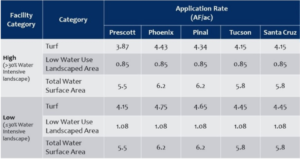By Tami L. Seekins, Esq.
If you live in Arizona, you should be concerned about water. Decreases in precipitation and increases in temperature continue to increase the need for water but reduce the supply available. Additionally, Arizona expects an increase in water demand due to future economic development and Arizona’s anticipated population growth.
Background
In 1980, Arizona recognized the need to manage the state’s finite groundwater resources and passed the Groundwater Management Act (the “Act”). The Arizona Department of Water Resources (“ADWR”) identified and designated five (5) active management areas (“AMAs”) based on their significant groundwater use. Each AMA established a Management Plan. Each Management Plan set its own groundwater goal. Each AMA must enact water use reductions over five decades to achieve those goals.
Currently, we are in the 3rd Management Plan. The 4th Management Plan will become effective January 1, 2023.
Management Plans and Community Associations
The ADWR recognized that “appearance is often deemed an important factor in attracting potential home buyers and satisfying the aesthetic concerns of existing residents.” As a result, community associations have installed turfed areas (which are typically overseeded and have relatively high water application rates), planted and maintained non-desert landscaping or mixed landscaping designs, and installed water features.
Management Plans directly affect community associations with ten (10) or more acres of water-intensive landscaped areas, which includes turf, landscaping with plants, and bodies of water. Currently, water application rates under the 3rd Management Plan are 4.9 acre feet/acre for turf, and 1.5 acre feet/acre for low water use applications such as desert landscaping.
The 4th Management Plan will reduce water application rates to 4.65 acre feet/acre for turf, while maintaining 1.5 acre feet/acre for low water use. The upcoming water restrictions may be incompatible with current landscape designs, water features, and the annual practice of overseeding.
On February 24, 2021, the ADWR proposed the following water reductions for the 5th Management Plan:

While the final water reductions are still unknown, it is certain that tehy are coming. Community associations with ten (10) or more acres of water-intensive landscaped areas should consider modifying their current landscape designs before the next reductions become effective. Community associations with less than ten (10) acres should also consider modifying any water intensive landscaping areas/features to reduce the overall cost to water and maintain those landscapes.
What Can a Community Association Do?
Community associations can:
- Assess the association’s current landscape design, water use, and costs;
- Share the results from the assessment with residents and explain the need to alter the current landscaping and the expected benefits;
- Seek and implement low water use landscape designs and technologies;
- Research programs and resources to assist with the costs or rebates offered for converting to less water intensive landscaping; and
- Begin budgeting for the costs necessary to make the conversions.
A Community Association’s failure to plan may result in unattractive landscaping, increased water costs, an increase in landscaping costs, and disgruntled members. By anticipating the upcoming water reductions, pro-active communities can continue to have aesthetically pleasing landscaping, attract home owners, and potentially reduce overall water and landscape costs.
The information provided herein is for reference purposes only, is general in nature, and is not intended as legal advice. For specific questions or legal issues regarding your association, please contact us at 480-219-3633.

